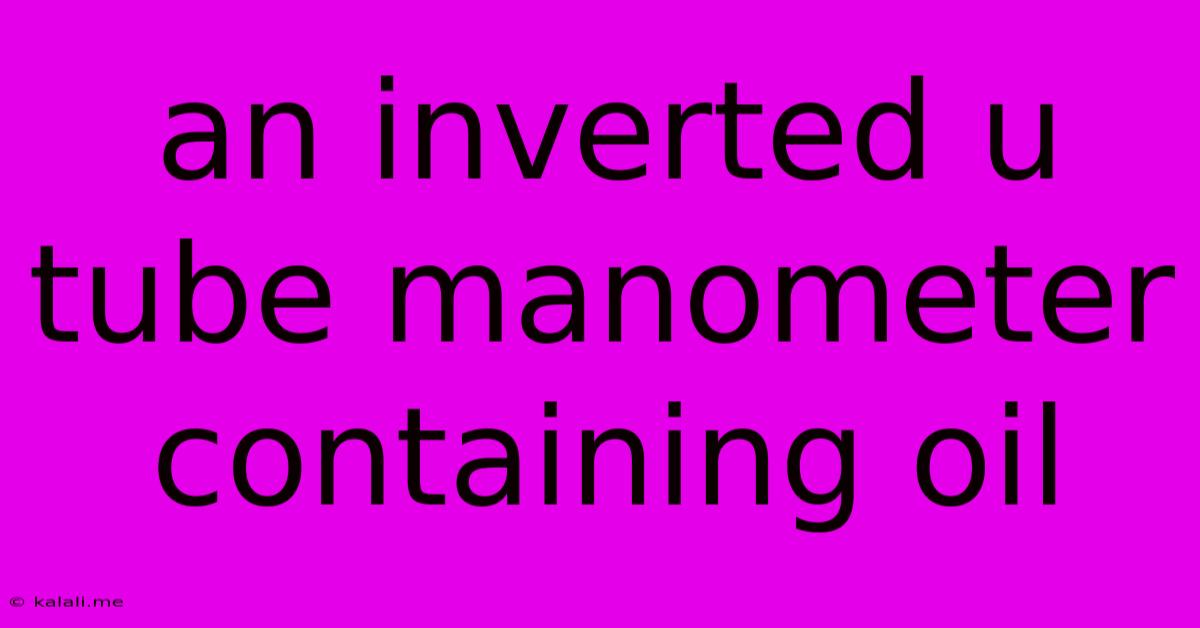An Inverted U Tube Manometer Containing Oil
Kalali
Jun 14, 2025 · 3 min read

Table of Contents
Understanding the Inverted U-Tube Manometer with Oil
This article will delve into the principles and applications of an inverted U-tube manometer filled with oil, exploring its functionality, advantages, and limitations. Understanding this simple yet effective pressure measuring device is crucial in various engineering and scientific applications. This guide will help you grasp the underlying physics and practical considerations involved in its usage.
An inverted U-tube manometer utilizes the principles of hydrostatics to measure pressure differences. Unlike a standard U-tube manometer where the fluid column rises on the high-pressure side, the inverted version utilizes a trapped air bubble within the U-tube. The height difference of the oil column on either side of the trapped air bubble is directly proportional to the pressure difference being measured. The choice of oil as the manometric fluid offers several advantages which will be discussed later.
How an Inverted U-Tube Manometer Works
The inverted U-tube manometer consists of a U-shaped tube filled with oil, leaving a trapped air bubble in the bend. One end of the tube is connected to the system whose pressure is to be measured, while the other end is typically open to the atmosphere.
- Pressure Application: When a pressure is applied to one side of the manometer, it compresses the trapped air bubble. This compression forces the oil level down in the pressurized arm and up in the open arm.
- Height Difference Measurement: The difference in the height (h) of the oil column in both arms is directly related to the pressure difference (ΔP) across the manometer. This height difference is then used to calculate the pressure.
- Calculating Pressure: The pressure difference is calculated using the formula: ΔP = ρgh, where:
- ΔP = Pressure difference
- ρ = Density of the oil
- g = Acceleration due to gravity
- h = Height difference of the oil column
Advantages of Using Oil in an Inverted U-Tube Manometer
Oil offers several advantages over other manometric fluids like water or mercury:
- Lower Density: Oil's lower density compared to mercury results in a larger height difference for the same pressure change, making readings easier to take and more accurate with less sophisticated measuring equipment.
- Viscosity: The viscosity of oil dampens oscillations, providing a more stable reading and reducing the impact of small pressure fluctuations.
- Immiscibility with Water: Oil's immiscibility with water is advantageous if the system being measured might contain water vapor or moisture.
Limitations of Using an Inverted U-Tube Manometer with Oil
Despite its advantages, the inverted U-tube manometer with oil also has limitations:
- Temperature Sensitivity: Oil density varies with temperature, potentially affecting the accuracy of pressure readings. Temperature compensation might be necessary for precise measurements in varying temperature environments.
- Limited Pressure Range: The pressure range measurable by an inverted U-tube manometer is limited by the height of the U-tube. Larger pressure differences necessitate a taller manometer or a fluid with a higher density.
- Air Bubble Movement: The air bubble's movement and potential leakage can affect the accuracy of measurements. Proper sealing and careful handling are essential.
Applications of Inverted U-Tube Manometers with Oil
Inverted U-tube manometers with oil find applications in various fields:
- HVAC Systems: Measuring pressure differences in heating, ventilation, and air conditioning systems.
- Automotive Engineering: Assessing pressure in various automotive components.
- Laboratory Experiments: Measuring small pressure differences in scientific experiments and research.
- Industrial Processes: Monitoring pressure in various industrial processes where accurate, low-pressure measurement is needed.
Conclusion
The inverted U-tube manometer with oil offers a simple, cost-effective, and relatively accurate method for measuring pressure differences. Understanding its operating principles, advantages, and limitations is crucial for its proper application and accurate interpretation of readings. While limitations exist concerning temperature sensitivity and pressure range, its ease of use and robustness make it a valuable tool in numerous settings. Careful consideration of these factors will ensure accurate and reliable pressure measurements.
Latest Posts
Latest Posts
-
Which Of The Following Is True Of The Mughal Empire
Jun 15, 2025
-
Syllabus Of Gate Exam For Ece
Jun 15, 2025
-
What Is The Human Body Resistance
Jun 15, 2025
-
Elements In Group 3 12 Are Called
Jun 15, 2025
-
Burning A Candle Is A Chemical Or Physical Change
Jun 15, 2025
Related Post
Thank you for visiting our website which covers about An Inverted U Tube Manometer Containing Oil . We hope the information provided has been useful to you. Feel free to contact us if you have any questions or need further assistance. See you next time and don't miss to bookmark.